As we saw in part 1 and part 2, the set of instruments built by Stradivari for the Medici court did not survive intact. In the late 18th century, two instruments separately left Florence and have never returned: the ‘Medici, Tuscan’ violin of 1690, which is currently part of the collection of the Accademia Nazionale di Santa Cecilia in Rome, and the 1690 ‘Medici, Tuscan’ contralto viola, now preserved in the Library of Congress in Washington, D.C. The history of these instruments and how they came to leave the Medici collection will be explored in this article.
Violin 1690, ‘Medici, Tuscan’
This violin is one of the instruments from the original set of two violins and a cello that Bartolomeo Ariberti commissioned and then presented to the Grand Prince Ferdinando de’ Medici. These three instruments appear to have been completed not before 1690 and today only two of them are known to have survived: the ‘Medici, Tuscan’ cello and this violin.
Experts have always held the violin in high esteem. Charles-Eugène Gand had the opportunity to see it in Paris during the second half of the 19th century and recorded it as ‘complètement intact’. [1]
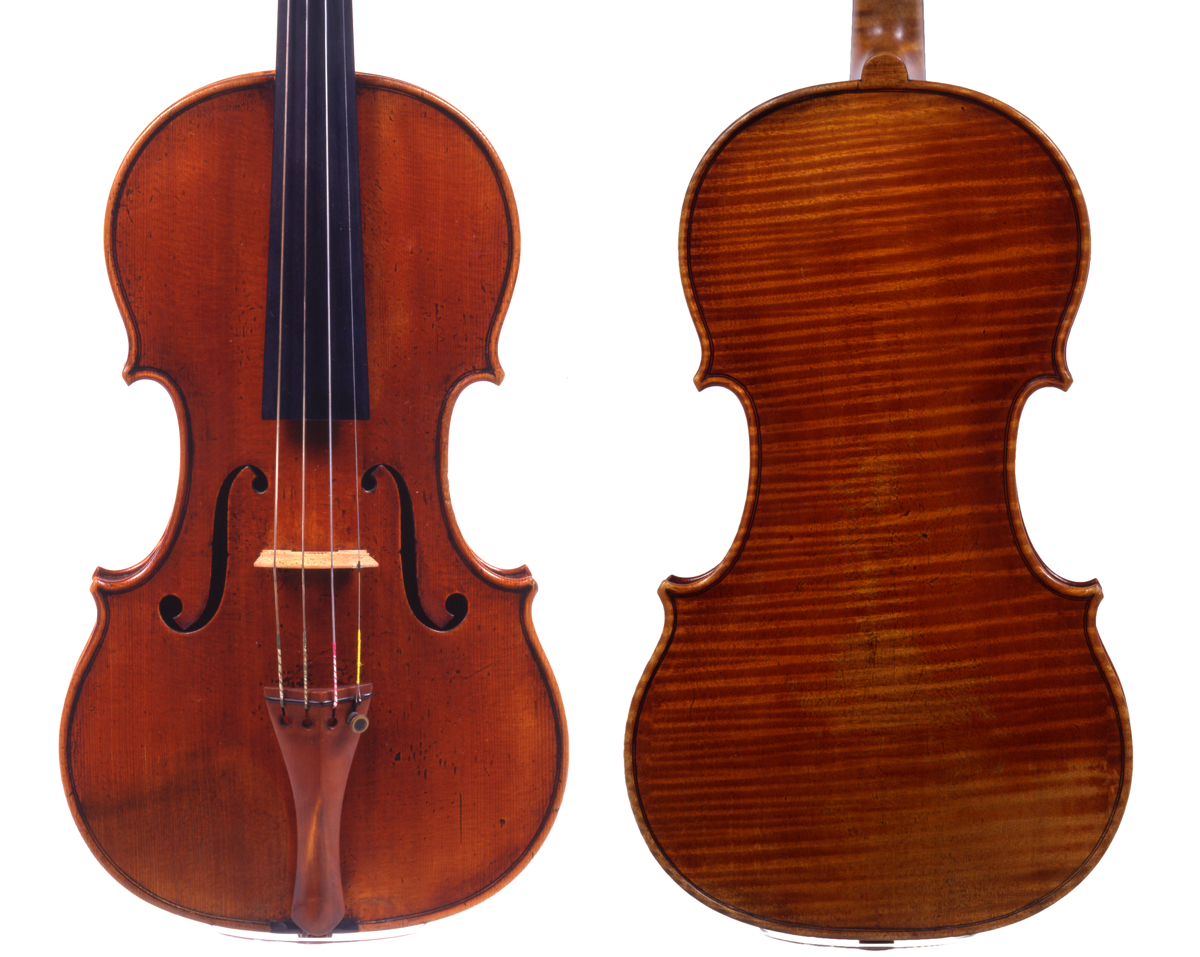
The 1690 violin left Florence after the death of the last Medicean Grand Duke in 1737. Photos: Rabatti & Domingie, courtesy Accademia di Santa Cecilia, Rome
More photosThe Hills examined it in 1888 and a year later published a brochure dedicated to it [2], which was updated in 1891. [3] Their appreciation of the instrument goes beyond anything they had previously written about any work by Stradivari. ‘This remarkable instrument, one of the finest examples of Stradivari’s work, is probably unique in the preservation, in every detail, of the original beauty of its form and workmanship. […] it is almost absolutely in the same state as when it received the last finishing touches from Stradivari himself. […] This instrument in particular shows how little fettered he was, even at this time, by the early influence of Amati, and marks his advance towards the culmination of his creative power in the grand pattern period of 1700 to 1725. In its flatter form, freer curves, and altogether bolder conception, it strongly suggests the later period, while possessing at the same time that microscopic perfection of workmanship which distinguished his earlier work. The exceptional fortune by which this violin has been preserved intact has happily fallen to one of the very finest instruments that ever left the Cremona workshop.’ [4]
The one-piece back is marked by regular, vivid curls, slanting up towards the right. Stradivari added extra wood in the lower part of the back to supplement the width of the instrument. The ribs are of a similar wood, while the head is characterised by slightly less intense flames, accentuated by the blackened chamfer. The table is of fine-grain spruce and the f-holes are particularly beautiful and perfectly cut. The measurements of the violin are the same as those of the ‘Dolphin’ from 1714, which shows how Stradivari had already found, in this relatively early stage of his career, a pattern that would accompany him with only minor alterations throughout his golden period. The varnish is of an orange-red-brown color.
Both the violins from 1690 appear to have originally been decorated, according to the 1716 inventory made by Bartolomeo Cristofori, custodian of the Medicean collection
Unfortunately the violin has lost its original tailpiece and fingerboard, which were probably inlaid with the Medici coat of arms. In fact, both the violins from 1690 appear to have originally been decorated, according to the 1716 inventory made by Bartolomeo Cristofori, custodian of the Medicean collection: ‘Two violins of Antonio Stradivari from Cremona […] the fingerboards with a carved decoration of mother-of-pearl reproducing the Medici’s coat of arms […]’ [5] The instrument still bears an original label, ‘Antonius Stradivarius Cremonensis Faciebat Anno 1690.’
The violin was restored by Jean-Baptiste Vuillaume in the first half of the 19th century, and in 1965 the Accademia di Santa Cecilia asked Simone Ferdinando Sacconi to reset the neck in its original position, at the request of the Italian violinist Pina Carmirelli.
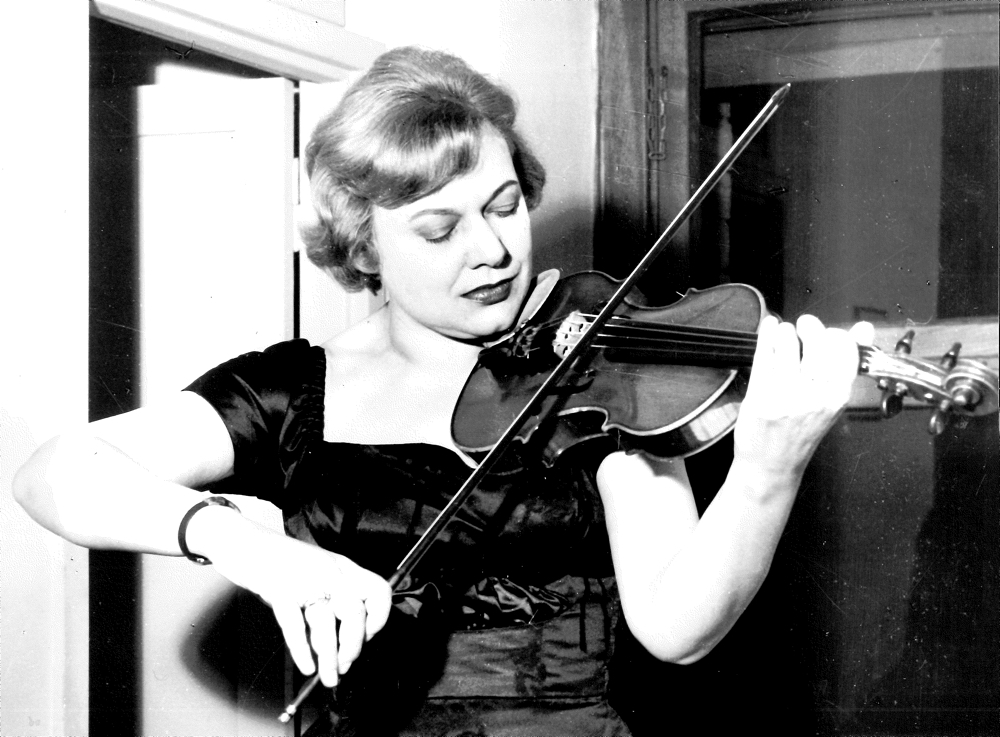
Pina Carmirelli, who played the 1690 ‘Medici’ violin from c. 1962 to 1977. Photo: Studio Bosio, Rome, courtesy of the Photographic Archive of the Accademia Nazionale di Santa Cecilia, Rome
It seems probable that the violin went straight from Stradivari’s workshop to the Medici court in Florence. After its disappearance from the Medici collection, rumours spread as to the possible reason. The Italian bassist and composer Isaia Billé [6] declared that two violins from the 1690 quintet were secretly exchanged while being moved from Palazzo Pitti to the Royal Institute of Music in 1863, to be later on sold to the Hills of London. Others such as Luigi Ferdinando Casamorata connected it to the French invasions that took place in the late 18-century. [7]
In fact the violin’s disappearance from the collection was largely due to the events that took place in Florence after the death of the last Medicean Grand Duke, Gian Gastone de’ Medici, in 1737. His sister Anna Maria Luisa, Electress Palatine, bequeathed the family’s art collection to the Tuscan State on the condition that every piece had to remain within the grand ducal state. But unfortunately this was not always the case. After 1737 the instruments of the Medici collection, for instance, were not handled with the same care and attention that had been granted to them in the past, resulting in some instruments leaving Florence for good.
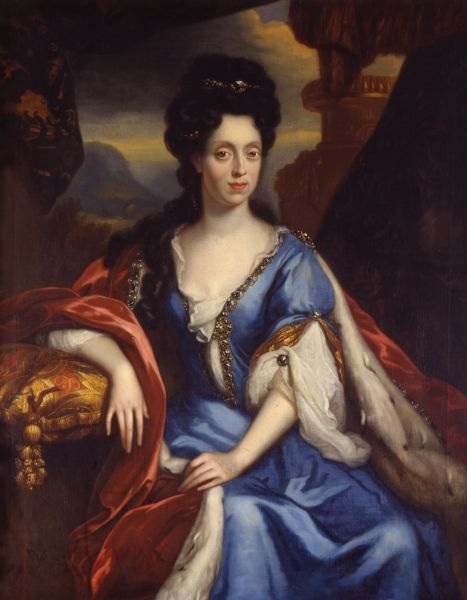
Anna Maria Luisa, last of the Medicis, by Jan van Douven. She bequeathed the family’s art collection to the Tuscan State in 1743
One of these was the 1690 violin: on May 10, 1794 it was sold for ‘Zecchini Cinquanta’ [8] (the equivalent of £40) by Giovanni Felice Mosell, [9] director of the Tuscan court, to David Ker of Donaghadee in Ireland. It is not clear if this was an unauthorised sale [10] as the violin may have been presented to Mosell by the Grand Duke. Although Ker bought the instrument, he appears not to have been particularly interested in violins and neglected this one until his heirs started a search for it through the various houses owned by him. The violin was officially rediscovered in 1847, as reported by the Hills: ‘About the year 1845, Portavo House, the residence of David Ker (son of the original purchaser) was destroyed by fire, and the family took refuge at Bangor Castle, Mr Ward’s seat. Among the chattels rescued from the fire and conveyed to the Castle was found the long-sought fiddle. It was enclosed in its original old leather-covered case, studded with brass nails and opening at one end; but was quite out of order, with no sound post.’ [11]
‘Among the chattels rescued from the fire and conveyed to the Castle was found the long-sought fiddle. It was enclosed in its original old leather-covered case, studded with brass nails and opening at one end; but was quite out of order, with no sound post’ – The Hills
Richard Ker, grandson of David Ker, took the violin to his friend F. Ricardo, an amateur violinist who lived in Paris. Ricardo brought the violin to Vuillaume for restoration and eventually bought it from Captain Alfred Ker, great-grandson of David Ker, for £250 in 1875. Ricardo then sold it to the Hills in 1888 for £1,000, according to their records. [12] The London dealers found a client for it in the collector Robert E. Brandt of Exeter, Devon, who possessed several fine instruments and bought the violin for £2,000 in 1890. [13] In 1904 Brandt exchanged it for another Stradivari and the ‘Medici, Tuscan’ was later purchased by Sir Charles James Oldham of Brighton, UK, who kept it until the end of his life. Oldham left instructions that on his death the instrument was to be put on sale by the Hills for £3,500 and if a buyer could not be found, it should be handed over to the British Museum. The violin went unsold but the prospect of a future spent in a glass cabinet caused such a controversy among musical circles that the British Museum thought it better to reject the gift. [14] [15]
The violin was then bought by the Hills who sold it first to Eric H. Rose and then to the collector Frederick Smith of Bowdon, Cheshire, in 1908. Smith retained possession of it until he died in 1914. The instrument returned to the Hills to join the vast collection of Richard Bennett of Lancashire, UK, in 1918. Upon Bennett’s death the violin returned once again to the Hills and in 1933 it was purchased by the amateur violinist and collector George H. Kemp of Totteridge in north London, who also owned the 1714 ‘Dolphin’. At the death of Kemp in 1940 the Hills regained possession of the violin, buying it from his widow, and retained it until 1953 when they sold it to the Accademia Nazionale di Santa Cecilia.
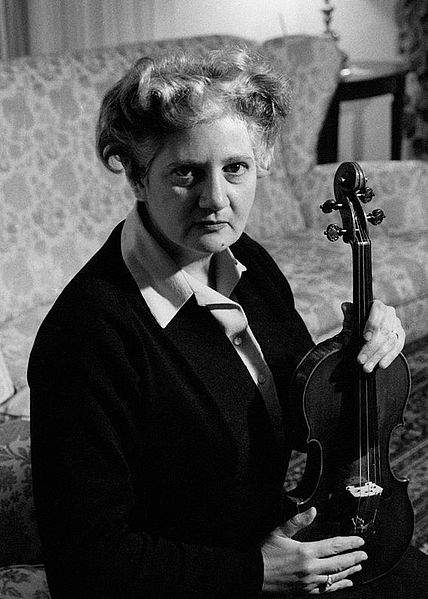
Violinist Gioconda de Vito, who was given lifetime use of the 1690 ‘Tuscan, Medici’ violin in 1953
According to Henley: ‘A large sum of money was put aside by Benito Mussolini for the purchase of this instrument, in view of his great interest in the celebrated violinist Gioconda De Vito, but the violin was not actually bought until October 1953, when the President of Del Consiglio Dei Ministri authorised the National Academy of St Cecilia, Rome, to buy the violin from Messrs. W. E. Hill & Sons, London, which they did for a record sum of £12,000. The instrument was then given over to Gioconda De Vito for use during her lifetime, but the Ministri stated that if the National Academy of St Cecilia should cease to exist at any time, the instrument would revert to the Italian Government.’ [16] Although this may be true, no evidence has been found so far to confirm this statement. Moreover, the sum paid by the Italian government to acquire the instrument was in fact £13,500.
The ‘Tuscan, Medici’ was played by De Vito until the end of her career in 1962 and was subsequently lent to Pina Carmirelli, who kept it until 1977. It is now back in the collection of the Accademia Nazionale di Santa Cecilia in Rome and exhibited in their Musical Instruments Museum, which opened in February 2008.
The violin was displayed in Cremona’s Stradivari exhibition of 1987. [17] It is illustrated in works by Dirk J. Balfoort, [18] George A. Dissmore [19] and Karel Jalovec. [20]
Contralto Viola 1690, ‘Medici, Tuscan’
This viola appears to be one of the two commissioned from Stradivari in 1690 by Ferdinando de’ Medici, the other being the tenor owned by the Istituto Cherubini in Florence. They were intended to join a group of two violins and a cello already in Ferdinando’s possession (see part 1).
Some experts have previously been convinced that the ‘Medici, Tuscan’ contralto had disappeared, the earliest being the Italian musicologist Giovanni De Piccolellis in the 1880s. [21] [22] The Hills, for example, described a viola from 1690 smaller in size than the ‘Medici’ tenor, but did not consider it directly connected with the latter or with the other instruments built for the Medici family. [23] They referred to it by the generic term ‘viola’, as did Henley. [24] Ernest Doring, however, was convinced that the viola was indeed part of the original Medicean quintet. [25] Only in a letter of 1957 to Cameron Baird did the Hills confirm the connection between this viola and the other four instruments from Florence: ‘We have reason to believe that this viola formed part of the Medici set of instruments, five in number, which were made by Stradivari in 1690 for Cosimo di Medici, Grand Duke of Tuscany.’ [26] They went on to describe the contralto as ‘one of the finest of the ten existing examples of the maker, its preservation being as remarkable as the beauty of its appearance.’ [27]
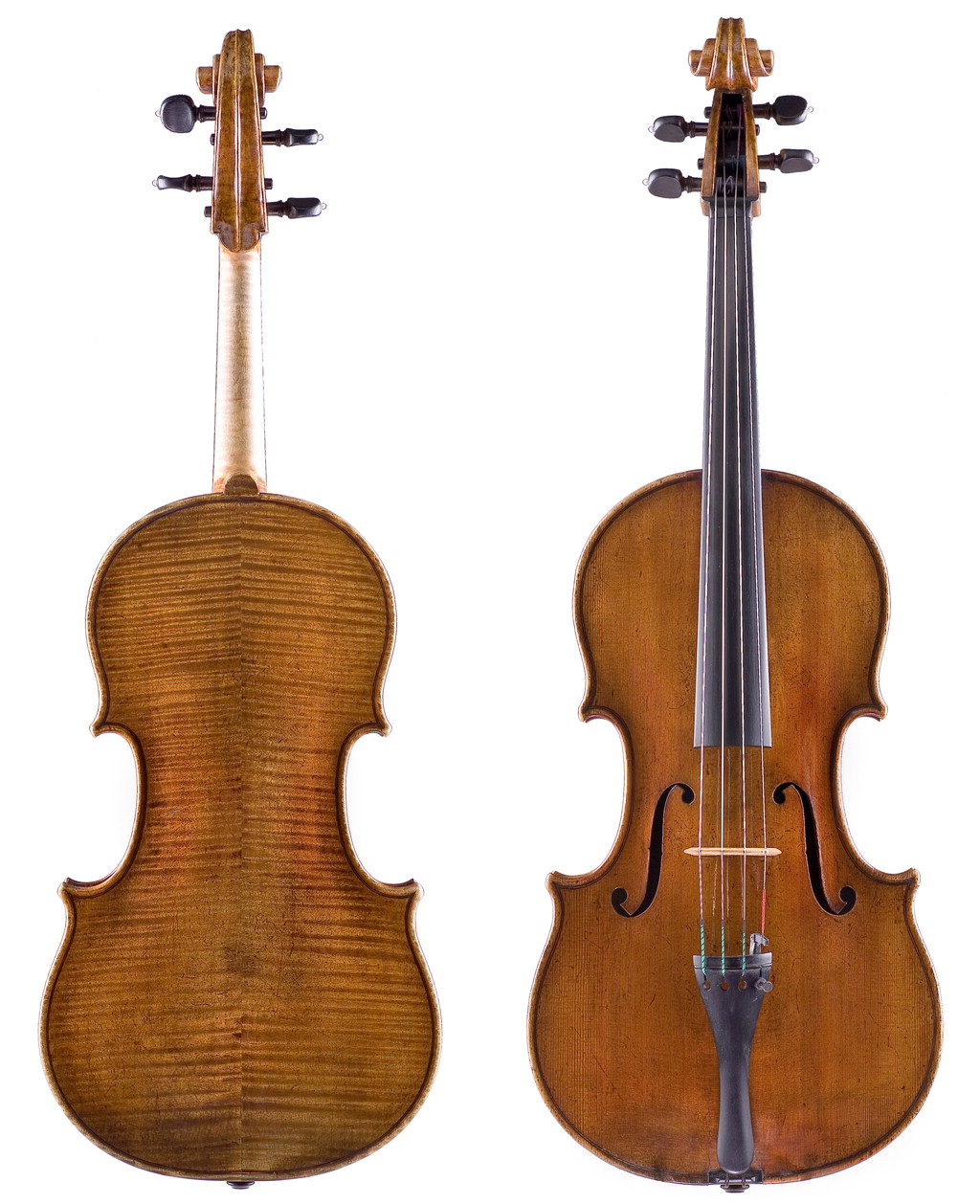
The 1690 ‘Tuscan, Medici’ contralto viola. Photos: Michael Zirkle, courtesy of the Library of Congress, Washington, Loan of the Tuscan Corporation
More photosThe mould and nearly all the paper templates that were produced by Stradivari for this viola have survived and can be seen at the Museo del Violino in Cremona; they are reproduced in the catalog of the former Museo Stradivariano [28] and Simone Ferdinando Sacconi wrote a detailed analysis of every item used for the construction of the viola. [29] The availability of such a wealth of original material enhances the historical value of this instrument, even more so as the mould for the viola can be recognised in later Stradivari examples including the 1701 ‘MacDonald’, the 1731 ‘Paganini’ and the 1734 ‘Gibson’. Made of walnut wood, the mould still bears a couple of notes in Stradivari’s handwriting, confirming the Medicean commission of the work and its production date: ‘1690 Forma nova per il … Fatta Ha Posta per il Ser.mo Gran. Principe di Firenze’ appears on the upper side, while on the lower: ‘CV Antonio Stradivari Adi 4 Ottobre 1690 forma nuova per il Contralto ossia Viola a quattro corde fatta ha posta per il gran. principe di Toscana, ossia di firenze C.V.’
It is still unclear in what circumstances the viola left Florence and when it reached England
The instrument has a two-piece back of maple cut on the quarter characterised by narrow curls, which run slightly downwards from the center joint towards the flanks. The sides and the head are of a similar wood. The scroll is excellently executed and follows the round style of Amati, which was replaced by a more oval form in later Stradivari instruments. The black chamfers of the head are still partially visible. The spruce of the top is finely grained at the centre, broadening towards the edges. Inside on the top of the upper treble bout is the inscription: ‘The Medici Stradivari / AH June 1913’ referring to the time when Alfred Hill had the viola. The f-holes are perfectly cut although a close examination shows that they are quite different from each other. The varnish is of a light brown-orange color. This instrument bears its original label dated 1690.
It is still unclear in what circumstances the viola left Florence and when it reached England. According to the Hills, the instrument ‘was bought by Mr. Bright from the Cavaliere Giantighazzi of Florence and sold to Betts for 45 guineas’. [30] But in their letter of 1957 the description became more accurate: ‘It was brought to this country from Florence prior to 1800, by Count Gian. Figliazzi, an Italian nobleman […]. We have proof of this instrument having been offered for sale by the firm of Norris & Barnes, the violin-makers and dealers, in 1793, the price asked being one hundred guineas, when it appears to have been purchased by a Mr. Bright. In 1803, it was again for sale and was acquired by Betts, the dealers, for forty-five guineas.’ [31]
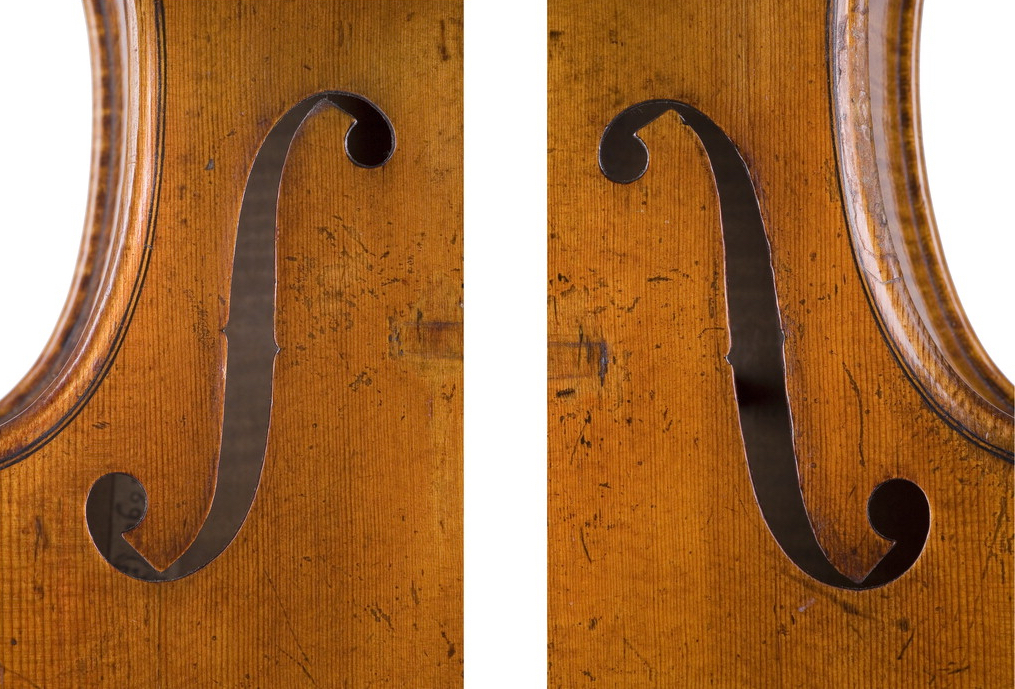
Close inspection of the contralto viola’s f-holes reveals that they are quite different from each other. Photos: Michael Zirkle, courtesy of the Library of Congress, Washington, Loan of the Tuscan Corporation
Afterwards it was possessed by Alexander Glennie, and subsequently by F. de Rougemont; both collectors who owned Strads that today bear their name. In 1840 Mr Avery-Tyrell, a prominent official of the Corporation of London, bought the viola from the dealers Davis, successors of Norris & Barnes, and kept possession of it until his death. At that point, the instrument, together with other two Strads – one of which was the ‘Tyrell’ of 1718 – passed to his son. On the death of the latter in 1913, the family sold all three instruments to the Hills. In 1924 the London dealers sold the viola to the American amateur chamber musician Herbert N. Straus, whose family owned Macy’s department store in New York. Later on the Hills re-purchased the viola. Charles Beare recorded that the acquisition of the viola by Straus took place via the Rudolph Wurlitzer Company of New York, [32] but although highly probable, the event is not mentioned by the Hills. In 1957 Cameron Baird, Chairman of the Music Department at the State University of New York, Buffalo, bought the instrument through Jacques Français. On his death in 1960 the instrument passed to his wife, Jane Baird, who transferred it to The Tuscan Corporation in December 1985. Currently the viola is on indefinite loan to the Library of Congress in Washington, D.C.
Besides Baird, the ‘Tuscan’ has also been played by Samuel Rhodes, Pinchas Zukerman and the Budapest Quartet (although it’s unclear which of the group’s two violists played it). The viola was exhibited in the Loan Exhibition at South Kensington in 1885 and in Cremona for the Stradivari exhibition in 1987. [33]
In addition to the publications already mentioned, the viola is illustrated in books from the Rudolph Wurlitzer Co., [34] Ernest Doring, [35] [36] Karel Jalovec [37] and Herbert Goodkind. [38]
These two 1690 instruments complete the original quintet made by Stradivari for the Medici court. One violin appears to have been lost and it was probably replaced with the 1716 violin that is displayed today in Florence. Nevertheless, the five instruments that have survived form one of the finest sets ever to have been made by the Cremonese master. Thanks to the patrimony of the Medicis, the world can still enjoy these more than 300-year-old masterpieces, which add to the fame of the entrepreneurial Tuscan family, of their beautiful city and of their legendary luthier Antonio Stradivari.
Alessandra Barabaschi is an Italian art historian and has authored several books. She held a lecture about the Stradivari Medici Quintet at the Library of Congress, Washington, D.C., in December 2018.
Notes
[1] Gand, Charles-Eugène, Stradivarius – Guarnerius del Gesù: Catalogue descriptif des instruments de Stradivarius et Guarnerius del Gesù, Les Amies de la Musique, Spa, reprint 1994, p. 72.
[2] Hill, W. E. & Sons, A short account of a Violin by Stradivari dated 1690, W. E. Hill & Sons, London, 1889.
[3] Hill, W. E. & Sons, The Tuscan, W. E. Hill & Sons, London, 1891.
[4] Hill, W. E. & Sons, 1889, Op. cit., p. 5.
[5] A.S.F. GM 1306bis, Inventario di strumenti, September 23, 1716.
[6] Billé, Isaia, Antonio Stradivari e i suoi favolosi istrumenti, Il regime Fascista, Cremona, April 14, 1937, p. 3.
[7] Letter from Luigi Ferdinando Casamorata, President of the Royal Institute of Music, to the Italian Finance Minister on January 7, 1869, reproduced in: Gai, Vinicio, Gli strumenti musicali della Corte Medicea e il Museo del Conservatorio ‘Luigi Cherubini’ di Firenze, Licosa, Florence, 1969, p. 40.
[8] Hill, W. E. & Sons, 1889, Op. cit., p. 7.
[9] Giovanni Felice Mosell was director and first violinist of the Court of Tuscany since 1774, as recorded in the inventory A.S.F. IRC 27, Affari del Dipartimento del Maggiordomo Maggiore, n. 56, August 11, 1774.
[10] Catalog of Antichi strumenti. Collezioni dei Medici e dei Lorena, Palazzo Pitti, Florence, February–December 1980, Giunti-Barbèra, Florence, p. 20.
[11] Hill, W. E. & Sons, 1889, Op. cit., p. 11.
[12] Hill, William Henry; Hill, Arthur Frederick; Hill, Alfred Ebsworth, Antonio Stradivari. His Life and Work (1644–1737), William E. Hill & Sons, London, 1902, reprint 1963, Dover, New York, p. 266.
[13] Lyon & Healy, Catalog of their Collection of Rare Old Violins: mdcccxcvi–vii, Chicago, 1896–97, p. 119.
[14] Doring, Ernest N., How Many Strads?, Bein & Fushi, Chicago, 1945, reprint 1999, p. 71.
[15] Henley, William, Antonio Stradivari, master luthier, Amati Publishing Ltd, Brighton, Sussex, 1961, p. 26.
[16] Henley, W., Op. cit., p. 26.
[17] Beare, Charles, Capolavori di Antonio Stradivari, Arnoldo Mondadori Editore, Milan, 1987, p. 44.
[18] Balfoort, Dirk J., Antonius Stradivarius, Continental Book Company A. B., Stockholm, 1945, p. 21.
[19] Dissmore, George A., The Violin Gallery, Des Moines, Iowa, 1890, p. 53 and p. 74.
[20] Jalovec, Karel, Italian Violin-Makers, Orbis, Praha, 1952, p. 471.
[21] De Piccolellis, Giovanni, Liutai antichi e modern, Successori le Monnier, Florence, 1885, p. 82.
[22] De Piccolellis, G., Esame della Viola e del Violoncello Mediceo, Atti dell’Accademia del R. Istituto musicale di Firenze. Dell’autenticità e del pregio di taluni strumenti ad arco, Galletti e Cocci, Florence, 1889, p. 30.
[23] Hill, W. H.; Hill, A. F.; Hill, A. E., Op. cit., p. 97 and p. 267.
[24] Henley, W., Op. cit., p. 89.
[25] Doring, E. N., Op. cit., pp. 69–70.
[26] Hill, W. E. & Sons, Letter accompanying the Certificate of Warranty, London, February 2, 1957.
[27] Hill, W. E. & Sons, Letter accompanying Certificate of Warranty, Op. cit.
[28] Mosconi, Andrea; Torresani, Carlo, Il Museo Stradivariano di Cremona, Cremonabooks, Cremona, 2001, p. 56.
[29] Sacconi, Simone F., I ‘Segreti’ di Stradivari, Libreria del Convegno, Cremona, 1972, English edition, reprint 2000, p. 203.
[30] Hill, W. H.; Hill, A. F.; Hill, A. E., Op. cit., p. 267.
[31] Hill, W. E. & Sons, Letter accompanying Certificate of Warranty, Op. cit.
[32] Beare, C., Op. cit., p. 46.
[33] Beare, C., Op. cit., p. 46.
[34] Wurlitzer Collection of Rare Violins, Violas & Bows, Rudolph Wurlitzer Co., New York, 1925, ill. XIII.
[35] Doring, Ernest N., How Many Strads? – Part Four, Violins, Vol. 1, No. 4, July 1938, Evanston, p. 136.
[36] Doring, E. N., Chicago, Op. cit., p. 69.
[37] Jalovec, K., Op. cit., p. 472.
[38] Goodkind, Herbert K., Violin Iconography of Antonio Stradivari, Larchmont, New York, 1972, p. 225.